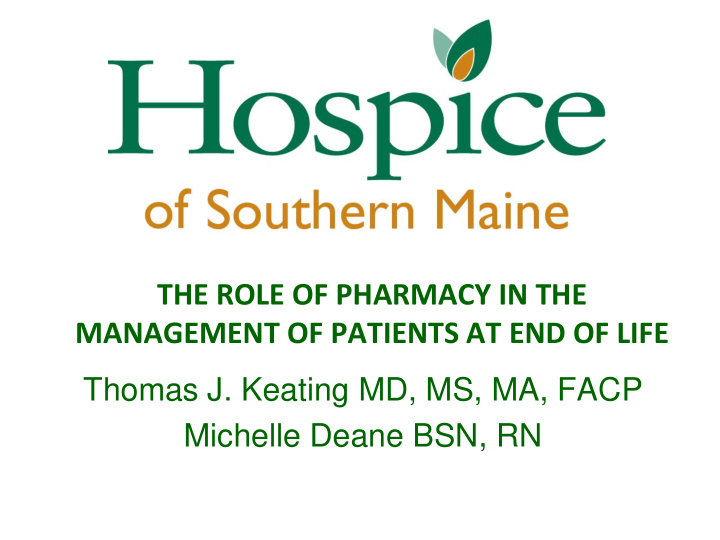



THE ROLE OF PHARMACY IN THE MANAGEMENT OF PATIENTS AT END OF LIFE Thomas J. Keating MD, MS, MA, FACP Michelle Deane BSN, RN
“You matter to the last moment of your life, and we will do all we can, not only to help you die peacefully, but to live until you die.” Dame Cicely Saunders Founder of St. Christopher’s Hospice London, England
Death and Dying in America • Disparity between the way people die/way they want to die • Patient/Family Perspective
The Need for Improved Palliative & End of Life Care • Late 1800’s • Early to mid 1900’s
Barriers to Quality Care at the End of Life • Failure to acknowledge the limits of medicine • Lack of training for healthcare providers • Hospice/palliative care services are poorly understood • Rules and regulations • Denial of death Glare et al., 2003; NHPCO, 2009
How do you talk to people about End of Life? • Lots of… – Empathy – Compassion – Authenticity – Honesty And open-ended questions.
Communication • Terminal illness is a family experience • Imparting information so individuals may make informed decisions • Requires interdisciplinary collaboration Kimberlin et al., 2004
Barriers to Communication • Fear of mortality • Lack of experience • Avoidance of emotion • Insensitivity • Sense of guilt
Barriers to Communication (cont) • Fear of not knowing • Disagreement with decisions • Lack of understanding culture or goals • Personal grief issues • Ethical Concerns
Open-ended questions like: • What brings you joy? • What is most important to you at this time in your life? • How are things going for you? • What has been most helpful to you?
Signs and Symptoms at End of Life
What are some of the visible indicators I might notice as a pharmacist? • Frequent/recurring hospitalizations • Weight loss • Increased: – Restlessness – Pain – Confusion – Agitation • Withdrawal from active social engagement
“Pain is whatever the person says it is, experienced whenever they say they are experiencing it.” Pasero & McCaffrey, 2011
Pain • 75% of end stage cancer patients have significant pain • Less research conducted in other chronic illness • Inadequate pain relief hastens death • Pain relief is essential at end of life
Barriers to Pain Relief • Importance of discussing barriers • Specific barriers – Professionals – Health Care Systems – Patients/Families Miaskowski et al., 2005; Paice, 2010; Pasero & McCaffrey, 2011
Pain Assessment • Acute vs. Chronic • Pain History – Location – Intensity – Quality • Nociceptive/Neuropathic – Temporal Pattern
Hospice at End of Life • Compassion • Care • Comfort
Hospice includes: • Interdisciplinary team approach – MD, NP, RN, MSW, Chaplain, Aide, Volunteer, and Bereavement support • Medications • DME • Short term inpatient/respite/continuous care
Payment for Hospice Services • Medicare • Medicaid • Most private health insurers • Private Philanthropy Hospice of Southern Maine will never turn away a patient, regardless of ability to pay.
Who Can Make a Referral to Hospice? • Physician • Friend – PCP or Specialist • Hospital case manager • Patient • Clergy • Family member • Pharmacist • Caregiver Anyone!
The Team • Nurse – Provides care, education, and oversees plan of care • Hospice Aide – Provides help with daily activities • Social Worker – Provides assistance with emotional, psychosocial issues • Chaplain – Specially trained to provide spiritual support at end of life • Volunteers – Companionship and assistance • Physicians – We have a team of physicians, all board-certified in hospice and palliative care
Work of the Hospice Team • Develops the plan of care • Manages pain and symptoms • Attends to the emotional, psychosocial and spiritual aspects of dying and caregiving • Teaches the family how to provide care • Advocates for the patient and family HSM provides bereavement support, free to anyone in the community.
Where is care provided? • Wherever the patient is: • In the home • Skilled Nursing Facility • Assisted Living Facility • Hospital • At our Gosnell Memorial Hospice House • In-patient residence in Scarborough • Palliation/management of acute medical symptoms • Short-term, intense symptom management • Respite care
What are the criteria for admission? • Certification of Terminal Illness – Prognosis <6 months – Certified by two physicians • Hospice Medical Director • Attending Physician • Progressive decline is ongoing and documented • Patient no longer seeking curative treatments (non-curative chemotherapy and radiation ok)
What is End of Life and How is it determined? • Definition – Artificial & Arbitrary • Physician Prognostication – Notoriously poor – Especially difficult for certain conditions
Why is it important to estimate prognosis?
What happens with medications when a patient is admitted to hospice? • Medication Review • Medications related to hospice diagnosis • Discussion with PCP, Pharmacist, Medical Director • Typically build trust before changing medications.
Pharmacy in Hospice • Per Diem model
Questions and Comments
Recommend
More recommend